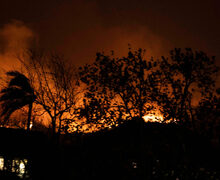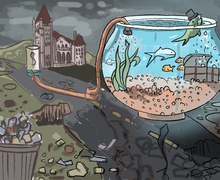DAPL victory is a battle won, the war rages on
/ The Daily Orange
Everything was covered with frost and the air was so thick that Emily Pomeroy, a senior at State University of New York’s College of Environmental Science and Forestry couldn’t see more than 30 to 50 feet in front of her. But this was just what they needed.

Frankie Prijatel | Senior Staff Photographer
The police would not be able to see the protestors from the ground, and the helicopters and small planes that flew over the camp 24 hours a day, every day, wouldn’t see them either. While construction workers packed up, protesters arrived to join those who had gathered on the side of the road. This was the Dakota Access Pipeline protest that Pomeroy experienced when she spent Thanksgiving break in Standing Rock.
At the top of the easement, Pomeroy and the crowd held signs, sang and prayed. Arms linked, people continued to gather. Others tied banners to the construction vehicles with phrases like “Mni Wiconi,” “NO DAPL,” “Water is Life,” and “You can’t drink oil.”
Other days weren’t so calm: Pomeroy saw police in full riot gear, helmets with face masks, bullet proof vests and carrying batons, giant canisters of pepper spray and some types of gun. With the success of the protesters’ efforts, their tenacity and strength has all but let up.
An environmental win has been reached in Standing Rock: On Dec. 4 the Department of the Army announced that it would not be drilling through the Standing Rock Sioux Reservation and they will be seeking an alternative route for the $3.7 billion project.
While the rerouting of the pipeline is a good thing, it’s not a complete victory for those at Standing Rock. The Dakota Access Pipeline will still be constructed and will continue to enforce our country’s dependence on fossil fuels. A bigger push needs to be made to move our energy toward renewable resources, and away from the oil and gas industry as a whole.
At its core, this is a breach of human rights. By putting the pipeline through Standing Rock, the Army Corps of Engineers would have perpetuated the United States’ history of neglecting native people. The Dakota Access Pipeline was proposed to run roughly 1,172 miles from North Dakota to southern Illinois — right through Sioux burial grounds. While this sacred land is safe for now, there is still the possibility of drinking water and irrigation systems pollution.
Energy Transfer Partners reports that the pipeline will carry 470,000 barrels of crude oil daily, so wherever it is built, the potential for an environmental catastrophe is high. If there is a leak along the pipeline massive amounts of oil will be spilled into the watersheds and land that will have detrimental effects on the environment.
The controversy and concern surrounding the DAPL brings to mind the Deepwater Horizon event of 2010. In just two months, a little more than 3.19 million barrels of oil had leaked into the Gulf of Mexico, reported by the Smithsonian Ocean Portal. Despite being so heavily regulated by the federal government and maintained to the proper safety standards, the oil rig still malfunctioned and caused a huge environmental and economic tragedy. Oil is a nonrenewable resource that releases large amounts of pollution into the atmosphere when it is used. As a country we need to move away from this fuel source and towards a cleaner form of energy production.
The pipeline would have covered a very defined area in the Midwest, potentially causing damage through the heart of where the United States’ wheat and other crops are grown. South Dakota, where the bulk of the pipeline will be, according to the Farmland Information Center there are 42,977,000 acres of farmland. This land requires immense amounts of water for irrigation and there’s a risk of that water getting contaminated with oil and again, gets to the heart of DAPL as a human rights issue.
Pomeroy’s biggest point about #NoDAPL, which she described more like a ceremony at times, was larger than just the concept of the pipeline. Protesters were fighting against bigger structures at work.
“It really highlights the amount of corruption in our political system, and how strong the ties are between politicians and big businesses,” said Pomeroy. “Our government is currently putting the interests of private corporations above the rights and the safety of the American people. It is a civil rights issue, a human rights issue, an environmental issue.”

Police wait on top of Turtle Island Thanksgiving Day as water protectors travel across first with canoes and then with their rudimentary bridge.
Frankie Prijatel | Senior Staff Photographer
The sanctity of the Sioux tribe is also a cause for concern: the land that they want to build through is sacred to them. There have been numerous attempts made for peaceful litigation between the Sioux and the construction company, but unfortunately it has turned into a warzone of peaceful protesters and violent opposition. This event at Standing Rock has further emphasized the U.S. government’s historical mistreatment of Native Americans.
The treaties created with them in the past have been broken time and time again. The pipeline is perpetuating our need for crude oil and use of fossil fuels. Our energy should be coming from a less harmful and renewable resource to lessen our impact on the climate and provide a cleaner world for future generations. Although there was a win in North Dakota, we need to continue the fight toward a more environmentally conscious future.
Max Kaczor is a senior environmental studies major. His column appears weekly. He can be reached at mjkaczor@syr.edu. He can be followed on twitter at @maxkaczor.
Published on December 7, 2016 at 10:27 pm





